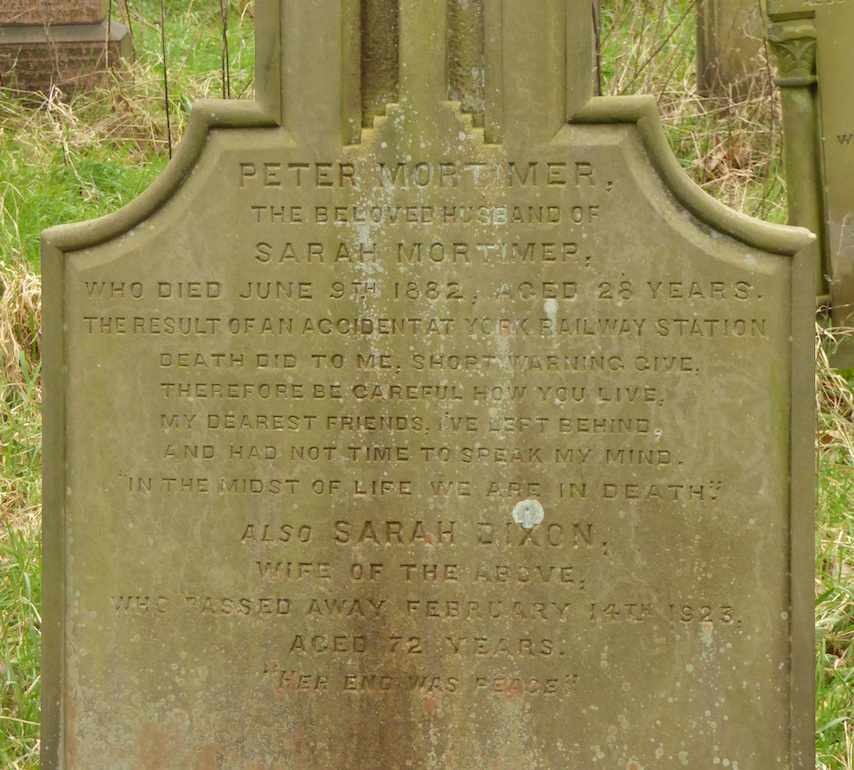Photographs by the author. Formatting and perspective correction by Jacqueline Banerjee. You may use these images without prior permission for any scholarly or educational purpose as long as you (1) credit the photographer and (2) link your document to this URL in a web document or cite the Victorian Web in a print one. [Click on images to enlarge them.]
Types of monuments




Three headstones in the shape of an obelisk. Left to right: (a) and (b) An Egyptian-style obelisk with its inscription. This is in memory of George Carlill, a slater, who died in 1881 at the age of 51. (c) Another obelisk in pink granite, this one marking the grave of three members of the Craven family. (d) An obelisk with a distinct lean, in memory of Ann Foster, the only child of Thomas Jackson, a builder, who died in 1880 when she was 35 years old.
The forms of the monuments are varied, though the great majority are round-topped or slightly pointed headstones; a few are sarcophagi and square pillars in the Roman mode; some are noticeable obelisks usually in pink or grey granite, most of them dating from before the arrival of Cleopatra’s Needle, and presumably indicative of the Egyptian Revival. Very few monuments are crosses, even fewer are Celtic crosses. A few striking large monuments are family memorials. Although many notable persons of York fame are buried here, there are not the extravagant memorials of some London cemeteries. This was not York’s richest period.
Symbolism




Left to right: (a) Clasped hands. (b) Hand pointing to heaven. (c) Angel. (d) Flowers.
Symbols used included easily understood hands, angels and flowers, but there are also freely adapted medieval, classical or Egyptian patterns. The headstone on the right above, topped by flowers, remembers several members of the Lupton family, including three sisters who all died young, one in infancy, one in her teens and one in her twenties.
Inscriptions
Inscriptions, apart from naming the dead and giving dates, sometimes use short biblical quotations; unlike the inscriptions of earlier or later centuries, there is not often excessive praise of the deceased. Sometimes the street the person lived in is named, and occasionally the reason someone died. Inscriptions of whatever sort tend to be long; the slabs are large compared to modern ones. One headstone is for Peter Mortimer, who died in 1882 as a result of a railway accident at York Railway Station, aged only 28, and for his wife Sarah, who survived him and died in 1923. The unfortunate husband's details are accompanied by this verse:

DEATH DID TO ME SHORT WARNING GIVE
THEREFORE BE CAREFUL HOW YOU LIVE
MY DEAREST FRIENDS I'VE LEFT BEHIND
AND HAD NOT TIME TO SPEAK MY MIND
This is followed by the text, "IN THE MIDST OF LIFE WE ARE IN DEATH"
Many memorials, like that to the Lupton family, bear witness to the high infant mortality rates of the earlier period. Others list successive generations of a family using the same grave-space so that the date of the actual memorial is not always clear. The identifiable graves were interspersed with the burials of the poorer classes who were not marked by a standing stone though some might aspire to a ledger stone (Murray 29-30).
Three notable monuments



Left to right: (a) Jonathan Gray's monument. (b) Henry Leetham's monument. (c) The Richardson family pillar.
The first chairman of the York Public Cemetery Company, Jonathan Gray, died in 1837 in Hastings, but is memorialised in York; the spire on the far left has the Gray family vault beneath it (Murray 18). The Gothic spire next to it is was erected towards the end of the Victorian era: Henry Leetham died in 1896, and further family names were added later, even on the risers of the steps. This monument is conspicuous on a junction in the paths. The Richardson family pillar (second from the right), dates to the middle of the century, and is grander than many similar commemorations: the family included a surgeon and an alderman. Also buried in York Cemetery, to the west of the cholera ground and quite near the cemetery’s first burial, is Hugh Murray himself, the historian and author of the book so useful in the present compilation.
Links to related material
- Egypt, Eygyptologists, and Victorian Egyptomania
- History and plan of the cemetery
- Cemetery Buildings (chapel and lodge)
- Boundaries (gates, railings and walls)
- Later history
Bibliography
Ellerby, William, and James Pigott Pritchett. Manuscript edited and introduced by Edward Royle. A History of the Nonconformist churches of York. Borthwick Institute of Historical Research, 1993.
Murray, Hugh. This Garden of Death: The History of York Cemetery 1837-2007. York: Friends of York Cemetery, 2008.
Pevsner, Nikolaus, and David Neave. Yorkshire: York and the East Riding. New Haven and London: Yale University Press, 2002.
Created 15 March 2022
Last modified 31 March 2022